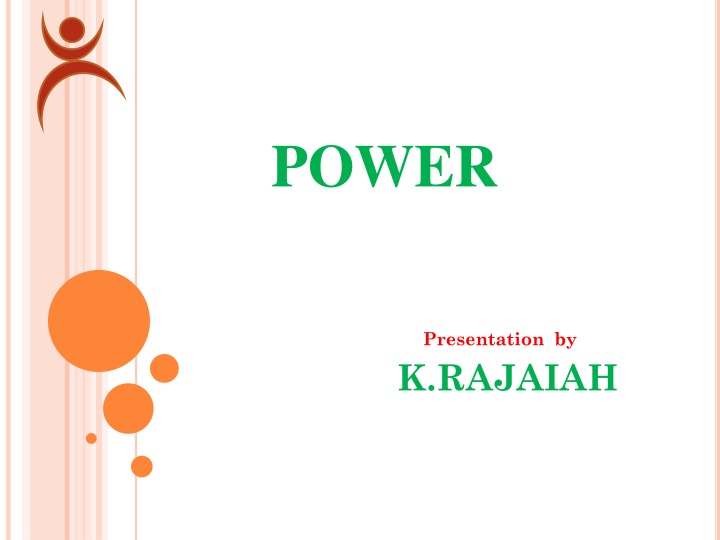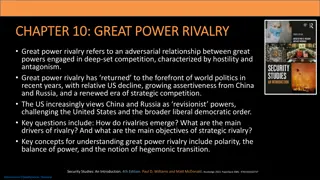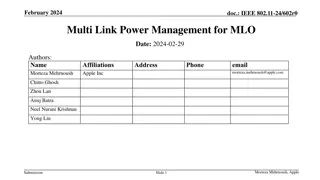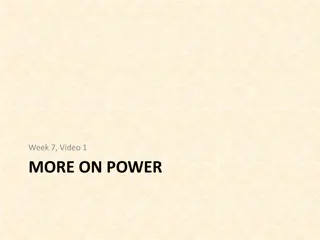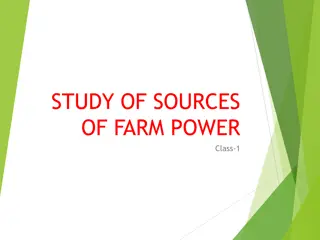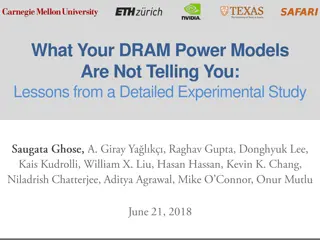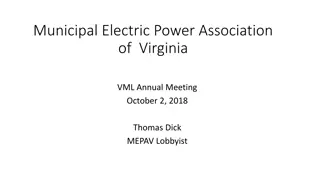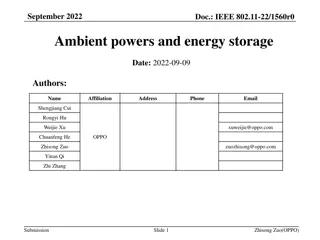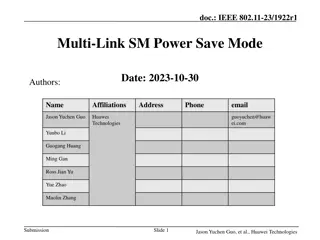POWER
This presentation by K. Rajaiah explores the fundamental concepts of power and work, covering definitions, units, special cases, and real-world examples. Learn about the rate of doing work, power in various contexts, and the relationship between work and power.
Download Presentation

Please find below an Image/Link to download the presentation.
The content on the website is provided AS IS for your information and personal use only. It may not be sold, licensed, or shared on other websites without obtaining consent from the author.If you encounter any issues during the download, it is possible that the publisher has removed the file from their server.
You are allowed to download the files provided on this website for personal or commercial use, subject to the condition that they are used lawfully. All files are the property of their respective owners.
The content on the website is provided AS IS for your information and personal use only. It may not be sold, licensed, or shared on other websites without obtaining consent from the author.
E N D
Presentation Transcript
POWER Presentation by K.RAJAIAH
AGENDA Introduction Definition and Units Special cases Power of motor Power of heart Power of lungs Work in terms of power Electrical power Power in Optics Power of a Wave 2
INTRODUCTION WORK : The work done by the the force is defined to be the product of component of the force in the direction of the displacement and the magnitude of this displacement. Thus Often it is interesting to know not only the work done on an object, but also the rate at which this work is done. For example, a person takes an abnormally long time to elevate his body up a few meters along side of a cliff. On the other hand another person might elevate his body in a short amount of time. The two persons might do the same amount of work but the second person does the work in less time than the first person. 3 2/19/2025 RGUIIIT BASAR
Example 2 Imagine two cars of same mass but different engines. Both the cars climb roadway up a hill. But one car takes less time where as another one takes more time to reach the top. So it is very interesting to know not only the work done by the vehicles but also the rate at which it is done. 4 2/19/2025 RGUIIIT BASAR
Example 3 To extinguish the fire in a building water is to be lifted up and sprayed on the fire as fast as possible. The fastness will be depend on the motor used to lift the water i.e, at what rate it is lifting the water( or doing the work). 5 2/19/2025 RGUIIIT BASAR
DEFINITION POWER:- The rate of doing work is called as power. or The rate at which work is done or energy is transferred is called as power. Like work and energy, power is a scalar quantity. 6
AVERAGEANDINSTANTANEOUSPOWER When a quantity of work is done during a time interval , the average work done per unit time or average power is defined to be W t W t = P av We can define the instantaneous power as the limiting value of the average power as approaches to zero. t W t dW dt = = lim t P 0 8
UNITSOFPOWER C.G.S System erg/sec M.K.S System joule/sec (or) kg m2 s-3 (or) watt In the British system, work is expressed in foot-pounds, and the unit of power is the foot-pound per second. A larger unit called the horsepower (hp) is also used: 1 hp = 550 ft.lb/s = 33,000 ft.lb/min That is, a 1-hp motor running at full load does 33,000 ft-lb of work every minute. A conversion factor is 1 hp = 746 W = 0.746 kW That is, 1 horsepower equals about of a kilowatt. 9
UNITSOFPOWER The watt is a familiar unit of electrical power; a 100-W light bulb converts 100 J of electrical energy into light and heat each second. The units of power can be used to define new units of work and energy. The kilowatt-hour (kWh) is the usual commercial unit of electrical energy. One kilowatt-hour is the total work done in 1 hour (3600 s) when the power is 1 kilowatt (103 J/s), so 1 kWh = (103 J/s) (3600 s) = = 3.6 MJ The kilowatt-hour is a unit of work or energy, not power. Our electricity bills carry the energy consumption in units of kWh. The dimension formula for power is given by ML2T-3 10
ALTERNATIVE FORMULAE FOR POWER __ Thus the power associated with force F is given by P = F .v where v is the velocity of the object on which the force acts. Thus P = F . v = Fvcos __ __ __ __ 11
SPECIALCASES Power = work/time = Energy/time =P.E/time = K.E/time = (mgh)/t = (1/2mv2)/t If a gun fires n bullets each of mass m with a velocity v in t seconds, the power of the gun is given by P = n(1/2mv2)/t 12
QUIZ 13
POWEROFMOTOR The power of a motor required to lift m kg of water from a well of depth h in time t is given by P = (mgh)/t (1m3 = 1000kg) If the efficiency of the motor is x% then P = (100/x)(mgh)/t 14
POWER OF MOTOR If a motor lifts the water from a depth h and delivers them with a velocity v in time t then the power of the motor is given by 1 2 P t + 2 mgh mv = 15
POWER OF MOTOR If a motor lifts the water from a depth h1 and then raises to a height h2 then the power of the motor is given by + ( ) mg h h = P 1 t 2 16
POWEROFHEART Power of heart = work/time = (F.s)/t = (PxA.s)/t = (PxV )/t = (hdgV)/t (P = pressure,A = area of vessel, V = volume of vessel and s = length of the vessel) Thus power of heart = P(V/t) = (hdgV)/t = Pressure x volume of blood pumped per second 17
HEARTPROBLEM The heart of a man pumps 4 litres of blood per minute at a pressure of 130 m.m. of Hg. If the density of the blood is 13.6 gm/c.c. calculate the power of the heart. Solution:- Power of heart = (hdgV)/t 3 3 3 (130 10 ) (13.6 10 ) 9.8 4 10 60 = = 1.155watt. 18
POWEROFLUNGS 1 2mv 2 Power of lungs = t mv t 1( ) 2 1 = 2 (mass of air blown per second ) x (velocity)2 2 = 19
WORKINTERMSOFPOWER The work done by from time t1 to time t2 is given by Where P = F.v F t 2 = Pdt W t 1 20
POWER If force F acted on a body of mass m which is at rest , then the power produced in that body in time t is given by P = F.v = F(F/m)t P = Fv = mav = ma(at) = ma2t V = u + at = 0 + at = at = (F/m)t 2 F t m = P 21
o A box of mass m moved along a straight line by a machine delivering constant power(P).Then the distance moved by the body in terms of m, P & t is given by Solution:- P=Fv = mav P= m(dv/dt)v vdv = (P/m)dt ,by integrating we get v Pt m 3 2 2 3 2 m P = x t 1 2 2P m 2 = v t = 2 dx/dt On integrating we get, 1 2 2P m 1 2 2Pt m = = dx t dt 3 2 3 2 x t 2 3 2 m P = x t 22
ELECTRICALPOWER Electrical power Instantaneous electrical power The instantaneous electrical power P delivered to a component is given by P(t) = V(t).I(t) where P(t) is the instantaneous power, measured in watts (joules per second) V(t) is the potential difference (or voltage drop) across the component, measured in volts I(t) is the current through it, measured in amperes If the component is a resistor, then: P = V.I = I2 .R where R is the resistance, measured in ohms. 2 V = R 23
Average electrical power for sinusoidal voltages The average power consumed by a sinusoidally-driven linear two-terminal electrical device is a function of the root mean square (rms) values of the voltage across the terminals and the current through the device, and of the phase angle between the voltage and current sinusoids. That is, P = V.I cos 24
Contd.. AVERAGEELECTRICALPOWERFOR SINUSOIDALVOLTAGES where P is the average power, measured in watts I is the root mean square value of the sinusoidal alternating current (AC), measured in amperes V is the root mean square value of the sinusoidal alternating voltage, measured in volts is the phase angle between the voltage and the current sine functions. 25
AVERAGEELECTRICALPOWERFOR AC Average electrical power for AC P T T 1 = ( ). ( ) i t v t dt 0 Where v(t) and i(t) are, respectively, the instantaneous voltage and current as functions of time. For purely resistive devices, the average power is equal to the product of the rms voltage and rms current, even if the waveforms are not sinusoidal. The formula works for any waveform, periodic or otherwise, that has a mean square; that is why the rms formulation is so useful. 26
POWERINOPTICS Optical power In optics, or radiometry, the term power sometimes refers to radiant flux, the average rate of energy transport by electromagnetic radiation, measured in watts. The term "power" is also, however, used to express the ability of a lens or other optical device to focus light. It is measured in dioptres (inverse metres), and equals the inverse of the focal length of the optical device. P = ( f in metres) 1 f 27
POWEROFWAVE The total power in one wave length of the wave is given by 1 2 = 2 2 E A A where = mass per unit length, = wave length, A = amplitude. As the wave moves along the string, this amount of energy passes by a given point on the string during one period of the oscillation. 28
Contd.. POWEROFWAVE Thus the power (or) rate of energy transfer associated with the wave is 1 2 2 2 A E T = = P T 1 2 1 2 = 2 2 ( ) T A v A = 2 2 P Thus, P v ; P ; P A2. 2 29
SUMMARY The rate at which work is done or energy is transferred is called as power. P = F . v = Fvcos Power = work/time = Energy/time =P.E/time = K.E/time = (mgh)/t = (1/2mv2)/t Power of motor Power of heart Power of lungs Electrical power Optical power Power of wave 30
This powerpoint was kindly donated to www.worldofteaching.com http://www.worldofteaching.com Is home to well over a thousand powerpoints submitted by teachers. This a free site. Please visit and I hope it will help in your teaching
